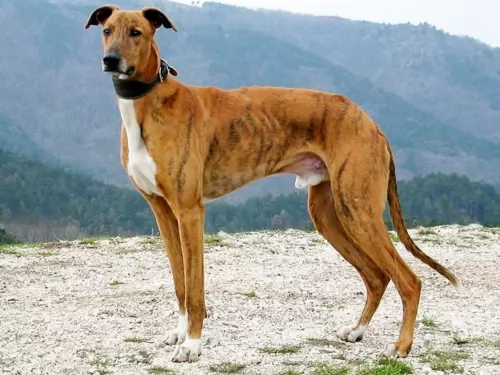 Petzlover
Petzlover Chesapeake Bay Retriever is originated from United States but Magyar Agar is originated from Hungary. Both Chesapeake Bay Retriever and Magyar Agar are having almost same height. Chesapeake Bay Retriever may weigh 14 kg / 31 pounds more than Magyar Agar. Both Chesapeake Bay Retriever and Magyar Agar has almost same life span. Both Chesapeake Bay Retriever and Magyar Agar has same litter size. Both Chesapeake Bay Retriever and Magyar Agar requires Low Maintenance.
Chesapeake Bay Retriever is originated from United States but Magyar Agar is originated from Hungary. Both Chesapeake Bay Retriever and Magyar Agar are having almost same height. Chesapeake Bay Retriever may weigh 14 kg / 31 pounds more than Magyar Agar. Both Chesapeake Bay Retriever and Magyar Agar has almost same life span. Both Chesapeake Bay Retriever and Magyar Agar has same litter size. Both Chesapeake Bay Retriever and Magyar Agar requires Low Maintenance.
 Fondly referred to as the Chessie, the ‘Labrador-look-alike’ Chesapeake Bay Retriever’s history extends to St. Johns Newfoundland pups which were rescued off a ship off the coast of Maryland in 1807. The Chesapeake is an American breed.
Fondly referred to as the Chessie, the ‘Labrador-look-alike’ Chesapeake Bay Retriever’s history extends to St. Johns Newfoundland pups which were rescued off a ship off the coast of Maryland in 1807. The Chesapeake is an American breed.
It is believed that the Newfoundland puppies as they grew, were bred with area dogs, with there being few records of the early dogs, but it is believed that spaniels and dogs were included.
In 1918 the Chesapeake Bay Retriever was recognized by the American Kennel Club and in 1964 the dog was declared the official dog of Maryland.
 The tall, slender Magyar Agar is a sighthound dog breed hailing from Hungary and which has been used for hunting and coursing, some dogs of which are still used for this purpose today.
The tall, slender Magyar Agar is a sighthound dog breed hailing from Hungary and which has been used for hunting and coursing, some dogs of which are still used for this purpose today.
Those who know the dog breed well will tell you that the dog isn’t the 'Hungarian greyhound', being a distinct breed with its own characteristics and breed designation.
They certainly go back centuries, and in fact, records tell us that they arrived in northeastern Hungary more than a thousand years ago.
 The Chesapeake is a large dog belonging to the Sporting breed group. Perhaps one of the more distinctive features of the Chesapeake Bay Retriever is the yellowish eyes.
The Chesapeake is a large dog belonging to the Sporting breed group. Perhaps one of the more distinctive features of the Chesapeake Bay Retriever is the yellowish eyes.
This is a strong, well muscled dog that stands anywhere from 61 – 66cm and weighs between 30 – 45kg. The short, thick coat of the dog is waterproof and comes in colors ranging from brown to reddish yellow to chestnut shades.
The head of the Chesapeake is broad and roundish with medium length floppy ears. The tail is long. The toes are webbed which helps makes the dog an excellent swimmer as well.
The Chesapeake Bay Retriever is a happy kind of dog with a bright, alert, intelligent expression. He loves water and is guaranteed to make a wonderful pet for any family.
With his wonderful characteristics, it is worth training him and socializing him as this training sets parameters for him so that he becomes a wonderfully obedient dog that gets on well with other pets in the home as well as with children.
 Described as a large dog resembling a Greyhound and being more longer in body than being tall they are more heavily boned than the fine-boned Greyhound.
Described as a large dog resembling a Greyhound and being more longer in body than being tall they are more heavily boned than the fine-boned Greyhound.
The Magyar is a large dog standing at between 62 – 70cm in height and weighing between 22 and 31kg. If you want your Magyar to have puppies, these dogs can produce between 6 to 10. The dogs have a smooth dense coat and the coat can be any color, but not black and tan or tri-color.
The ears of the dog are short to medium and are semi-erect, semi-floppy and most times held back. The tail of the dog is long.
These are hardy dogs, and even with their short coats they are able to cope with lower temperatures. They are quiet and docile and are loving towards their human family. They also have a strong instinct to guard their owners.
They are amicable dogs, getting on well with children and pets in the home.As with most dogs, he can benefit from training and socialization. He is an adaptable dog too and will settle into life in the city or the countryside, but wherever he lives, he will need to be exercised well.
They love cozying up to their owners on the couch and thoroughly relaxing, but they also love being out and about too. A walk in the countryside or the park is a a chance to be let off the leash for some running.
 The Chesapeake Bay Retriever is ready to be your best friend and companion. This dog breed is highly active and he’ll fit easily into a family that is active and can ensure he is involved in all their activities.
The Chesapeake Bay Retriever is ready to be your best friend and companion. This dog breed is highly active and he’ll fit easily into a family that is active and can ensure he is involved in all their activities.
The beauty about the Chesapeake Bay Retriever is that he is generally an even tempered dog, and once trained and socialized, becomes a truly splendid pet, one that will be loving and loyal with his owners.
 The Magyar Agar may well have been developed for hunting, but today he makes a splendid pet.
The Magyar Agar may well have been developed for hunting, but today he makes a splendid pet.
He is intelligent and quiet, as well as being loyal. While he loves being outside playing or going on walks, he is quite happy to curl up on the couch with you – the nearness to you is what he loves.
Beautiful and loving, this dog symbolizes the best qualities that man wants in a canine friend.
 By taking good care of your Chesapeake, you can ensure his teeth remain strong, his nose is wet and his coat glossy and healthy. He is a robust breed as it is, but there are always some common dog diseases to watch out for -
By taking good care of your Chesapeake, you can ensure his teeth remain strong, his nose is wet and his coat glossy and healthy. He is a robust breed as it is, but there are always some common dog diseases to watch out for -
Obesity is an ailment that is afflicting many humans and their pets. Being overweight can bring on a host of unwanted diseases. Obesity is a serious disease that can contribute to digestive disorders, back pain, heart disease and joint problems.
Instead of showering him with little treats to show him how much you love him, rather stroke him or play a game with him – it’s the ultimate treat for him – your attention.
Remember that if you aren’t going to let your Chessie become a parent, the best thing you can do for your male or female is to have them spayed or neutered. In fact, spaying or neutering can decrease the likelihood of your pet getting certain types of cancers as well as other illnesses. Speak to your vet and discover how these procedures can be very beneficial for your pet.
 The Magyar Agár is looked upon as a healthy dog breed, and with good care can live to be 12 to 14 years of age. With this dog you want to be on the lookout for some of the common dog illnesses he could succumb to -
The Magyar Agár is looked upon as a healthy dog breed, and with good care can live to be 12 to 14 years of age. With this dog you want to be on the lookout for some of the common dog illnesses he could succumb to -
This is a fairly common problem in dogs. The thyroid gland produces the hormone thyroxine with other thyroid hormones. Playing a role in the dog’s metabolism, when the thyroid is out of sync it can cause problems for your dog.
Hypothyroidism happens when your dog doesn’t secrete enough of the thyroid hormones, slowing the dog’s metabolism. Some of the symptoms include obesity, lethargy, coat thinning and cold intolerance.
This is an inherited disease of the retina, occurring in both eyes together. Thankfully it isn't painful for the dog. There are different types of inherited retinal degenerative diseases in dogs and the first signs of this are seeing your dog with night-blindness and the pupils being dilated. There is no cure, but specific antioxidant supplementation does help support the retinal health of the dog and can actually help to prevent vision loss.
Itching outbreaks from a skin allergy can make your pet miserable with constant licking and biting. Whether these allergies are inhaled, food related or from flea bites, they can cause your pet great discomfort. The fur or coat may even have started to fall out in patches. Allergies like this can occur when the dog's immune system is weakened. Feeding your dog some raw meat, getting him to the vet and providing excellent grooming can help with your pet’s skin problems.
 The Chesapeake Bay Retriever sheds fairly heavily throughout the year. The coat should be brushed at least twice a week to remove dead hair. Brushing is good for the dog too as it distributes the oils of the skin, making his coat shinier.
The Chesapeake Bay Retriever sheds fairly heavily throughout the year. The coat should be brushed at least twice a week to remove dead hair. Brushing is good for the dog too as it distributes the oils of the skin, making his coat shinier.
Because the Chesapeake has floppy ears, the ears will need to be checked on a weekly basis for signs of infection. This is of particular importance if your Chessie loves to spend time splashing around in water. The veterinarian can recommend and also advise on cleaners for your dog’s ears.
An excellent diet and plenty of exercise will ensure your Chessie can live to be 11, 12 or 13 years of age. You want to keep his diet of kibble, rice, vegetables and meat consistent so as not to upset his stomach.
Avoid giving him foods such as chocolates. Do research on the harm you can do to your pet when you feed him some human foods that are entirely not meant for a dog’s digestive system.
The Chesapeake Bay Retriever has always loved to be active - hunting for- and retrieving birds from rivers and lakes. He is used to being active and will require a good supply of exercise. Take him for long walks and let him join you on your runs or your cycling.
 Make sure you take wonderful care of your Magyar Agar. It is a social, living creature who needs to be loved and cherished.
Make sure you take wonderful care of your Magyar Agar. It is a social, living creature who needs to be loved and cherished.
Provide him with the best food there is. If you invest in dry kibble, try and add in cooked chicken, brown rice and raw or cooked vegetables from time to time as well as some raw meat. Keep the diet simple to avoid digestive upsets.